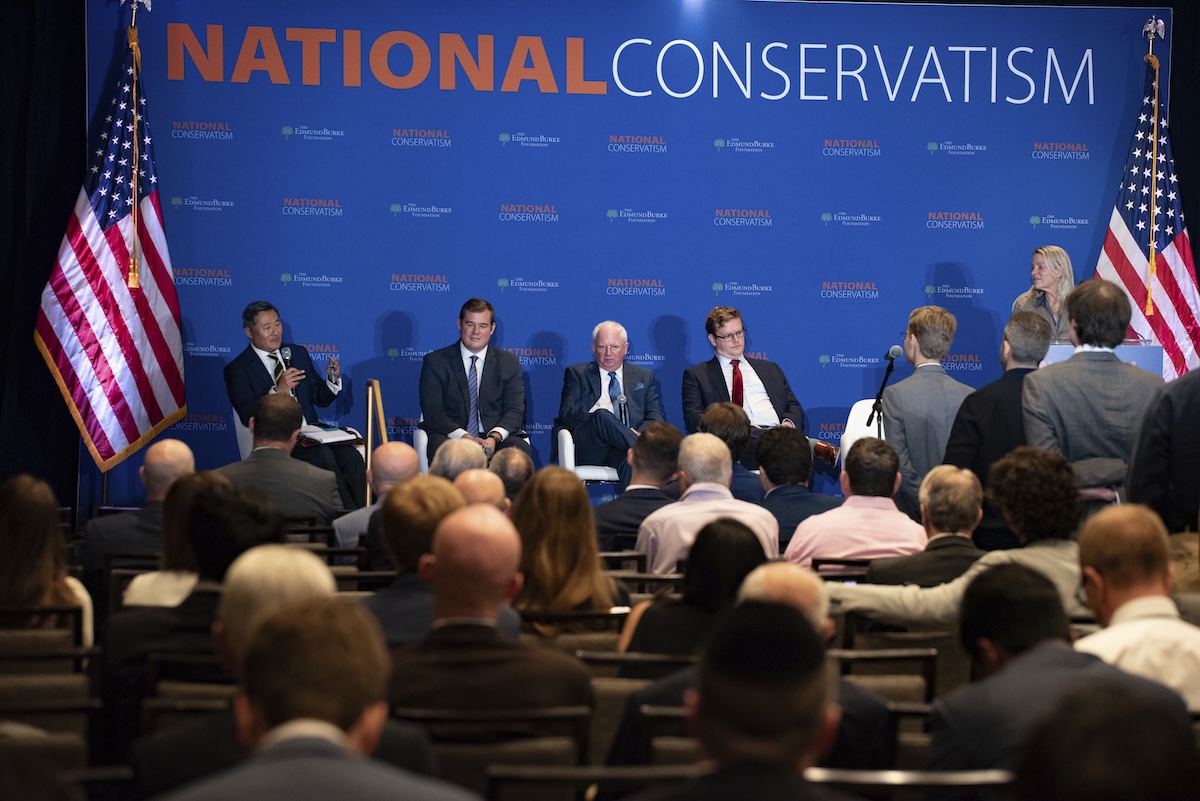I have tried for years to understand just what National Conservatism is. I now know. After reading dozens of essays, writing three, attended two NatCons, and engaging in innumerable conversations, I finally see the essence. It has been a journey of confusion, fustigation, alarm, appreciation, consideration, and finally a quiet, resigned understanding. In understanding, I have found peace, and if not agreement, a sweet release. As Maharishi Mahesh Yogi says, “Those who don’t know, they don’t know; those who know, they enjoy.”
My journey to NatCon 4 in Washington, D.C., began with signs and portents from the Kent District Library. While walking to my gate through Terminal A of the Gerald R. Ford International Airport, I spied a small book kiosk. For the local traveler’s convenience, the KDL had stocked a small shelf of books to be had for the taking. A cover with the nation’s capital in one corner balanced by the Statue of Liberty in profile on the opposite corner caught my eye. The background was fittingly storm clouds, as the title was The Great Controversy: The Storm Is Coming. The controversy in that title is between Jesus Christ and Satan, and the author one of the founders of the Seventh-Day Adventist Church, Ellen G. White. The controversy I was heading for was more provincial and less cosmic, although given the rhetoric, you might not know that.
The story of National Conservatism told by its champions and critics is one of conflict, a fratricidal war of ideas on the American right. At the inaugural National Conservatism Conference in 2019, Yoram Hazony, chairman of the Edmund Burke Foundation, triumphally announced: “Today we declare independence from neoconservatism, from neoliberalism, from libertarianism, from what they call classical liberalism.” An incessant volley of ideas, criticism, ridicule, and demonization has flowed back and forth from all camps since. Attempts at reproachment have been made, including at NatCon 2, in 2021, where Hazony himself floated the idea of an alliance between national conservatives and at least some “anti-Marxist liberals” to revive the old conservative fusionism along different lines.
By the third NatCon, in 2022, however, such calls had abated. The Republican Party’s second most popular politician, Florida governor Ron DeSantis, was a keynote speaker, and the imprimatur of Kevin Roberts, president of the American conservative movement’s most well-funded think tank, the Heritage Foundation, was given. National Conservatism was ascendant. Ohio senator J.D. Vance, now the Republican nominee for vice president of the United States, has been the closing speaker at two NatCons. If the tone was triumphant at NatCon 3, it can only be described as domineering at NatCon 4.
In the summer of 2022, “National Conservatism: A Statement of Principles” was published simultaneously in theAmerican Conservative and the European Conservative. Writing for Religion & Liberty at the time in the essay “National Conservatism One Year Later,” I was hopeful that the list of principles might bring a clarity to a movement often ill-served by the dehumanizing and incendiary rhetoric of its most intemperate champions. It was a nuanced statement that could serve as an invitation to further dialog rather than a pretext for the ossification of division.
Many thoughtful responses came from all corners of the political spectrum, and none was more important than “Freedom Conservatism: A Statement of Principles.” The FreeCon declaration drew inspiration from the Young Americans for Freedom’s founding statement of principles. Drawn up in the home of William F. Buckley Jr. in Sharon, Connecticut, in 1960, the “Sharon Statement” became a canonical text of “fusionism,” a strain of American conservatism that saw a synthesis between social conservatism and right-liberalism as right and natural. This idiom of American conservatism would dominate not only the American conservative movement but also the Republican Party for the next 55 years—from Ronald Reagan’s nomination in 1980 to Donald Trump’s in 2016. “Freedom Conservatism: A Statement of Principles” attempted to rearticulate this fusionist synthesis in a contemporary context and was crafted in part to respond to the ascendant National Conservatives, who had proclaimed it “the dead consensus.”
The FreeCon statement was almost entirely ignored at NatCon 4. The only time I heard it mentioned was in the opening address of the conference. Chris DeMuth, chairman of the National Conservatism Conference, was dismissive, calling it, “totally insipid and anodyne,” further claiming that “after a few days of puffery it disappeared without a trace.” This was shocking coming from a man whom I had heard extol the virtues of Adam Smith and Michael Novak at NatCon 2. It was also strange in light of the fact that several signatories of the FreeCon statement had spoken at prior NatCon conferences. Finally, Rachel Bovard, VP of Programs at the Conservative Partnership Institute, expressed the overwhelming sentiment of the plenary speakers when she claimed that National Conservatism simply “is the conservative movement.”
But what does it mean for National Conservatism to be the conservative movement? Is such identity the product of ideological victory or flexibility? Vivek Ramaswamy, the founder of Roivant Sciences and presidential candidate in the 2024 Republican primary, may be the solution to this puzzle. He began his plenary address by expressing the concern that he thought too many in the “America First Movement” had become complacent, mouthing words whose meaning they had long since forgotten. In short, they had become victims of their own success.
He commended to the conference attendees an agenda of “National Libertarianism” opposed to a “National Protectionism.” Ramaswamy claimed that both reject an economic reductionism that the “neoliberal consensus” embraced in favor of a perspective that is centered on the welfare of America and her citizens. He then proceeded to walk through the broad issues of contention in foreign policy, immigration, and trade. In short, “National Protectionists” fail actually to put America first because of fundamental misunderstandings about how the economy works, whereas “National Libertarians” successfully put Americans first by having public policy informed by, but not in service of, the economy. His speech was the most enthusiastically received of the conference.
Bovard had mentioned in her address that National Conservatism was a “perspective.” It is a way of seeing the world as one embroiled in a clash of civilizations. In the West, it is being fought along an axis of nationalists and globalists. International capital, NGOs, multinational corporations, the “woke,” academia, the “left,” and DEI HR managers are prosecuting a war on the nations of the world from within and without. Communist China is sometimes included among the globalists and at other times viewed as a distinct threat along with other communist regimes. Reza Pahlavi, Crown Prince of Iran, astutely pointed out in his address that Islamism is also a global movement, one he believes is best challenged by a resistance national in character.
National Conservatives, standing triumphantly astride the more “traditional” American conservative movement, see themselves as essentially defeated in the broader American society. No one bothers to ask if these two developments are related. Rt Hon Suella Braverman KC MP recounted the Conservative Party’s historic defeat in the recent parliamentary elections. Reform UK, the party of Nigel Farage MP, which is more aligned with National Conservatism than are the Torys, fared even worse, resulting in a landslide Labour victory. Balázs Orbán, a Hungarian member of parliament for Fidesz, reported on the Hungarian government’s national conservative agenda and also the hostility it faces in broader Europe. Only Ram Madhav, former national secretary of the Bharatiya Janata Party, appeared to be living his best life.
In a boisterous, upbeat, and compelling address, Madhav rattled off a litany of policy successes by India’s ruling party. He also reported that India was taking an increasingly prominent role in international affairs. He credited the ruling party with ending socialist protectionism and embracing the free market economy. While insisting that he was comfortable with the label “Hindu nationalist,” it should not be understood as a religious but rather a cultural nationalism, and boasted that in India “it is cool to be a Hindu, it is cool to be a Buddhist, it is cool to be a Jain, it is cool to be a person of religion.”
Madhav is of course correct that Hindu nationalism is a cultural rather than a religious project. Hindu nationalism’s original theorist, Vinayak Damodar Savarkar, was a self-described atheist who counted religious Hindus, Jains, Sikhs, and Buddhists as cultural Hindus and thus members of the “Hindu nation” (Hindu Rashtra). Christians and Muslims, whose faiths originate outside the Indian subcontinent, according to Savarkar, fall outside Indian civilization and thus the Hindu nation. Perhaps this is why Ram Madhav did not mention them by name. I am left wondering: Is it cool to be a Christian or a Muslim in a Hindu nationalist India?
In a panel moderated by Yoram Hazony, Al Mohler, president of The Southern Baptist Theological Seminary, and Doug Wilson, senior minister of Christ Church in Moscow, Idaho, had difficulty with an analogous question. During the panel, Mohler expressed a desire to “maximize the Christian commitments of the State, of the civilization.” Hazony asked, in light of this panel, what would be the place of non-Christians in such a nation. Wilson claimed that Jews would be treated better than they are today in America, while Mohler insisted that Jews would be respected but that people of other faiths must acknowledge “that this is a nation with specific theological accountability and theological commitments.” I do not know what that means.
The place of religion in National Conservatism is still undertheorized. This was clearest in the opening remarks of Yoram Hazony, who referenced recent legislation to mandate the posting of the Ten Commandments in public schools. Hazony remarked that he was tired of religious people quibbling about details such as which version of the commandments should be posted or how they should be explained to students. “Just put them up on the wall!” Later in the conference, it was mentioned that, in classrooms, either the Ten Commandments or the pride flag must hang. These are to be proxies in the battle between nationalism and globalism, with the lines of control advancing or retreating classroom by classroom across America.
If religion itself is subsumed into nation, filtered through the National Conservative perspective, and then instrumentalized and weaponized in a struggle against globalism, it is hard for me to believe that anything else would be sacred. Maharishi Mahesh Yogi, when he returned to India after teaching in the West, was asked why he taught a health-and-wealth prosperity Hinduism. He said, “I tell them what they want to hear now so that I can tell them what I want to tell them later.”
There were fascinating discussions about all aspects of America and the challenges it faces in many of the breakout sessions. But realizing the essence of the thing revealed them to be mere side shows and rabbit trails regardless of their individual merit. The National Conservative perspective today may be abandoned tomorrow. For tariffs one day, against them the next. For raising corporate tax rates one day, for lowering them the next. Pro-Life one day, Pro-Choice the next. National Libertarian or National Populist, as long as it’s national. Such is the perennial danger of seeing the world though a lens of the great controversy.

